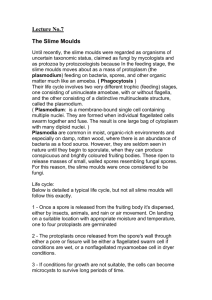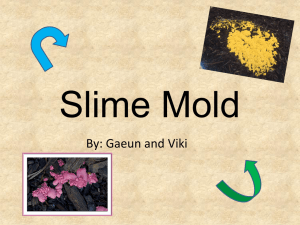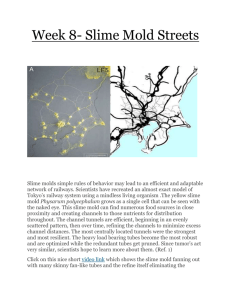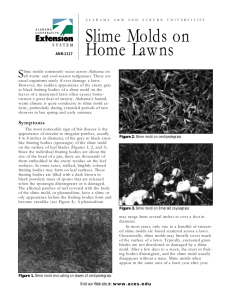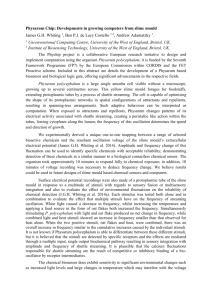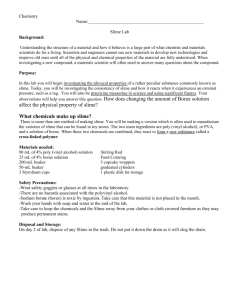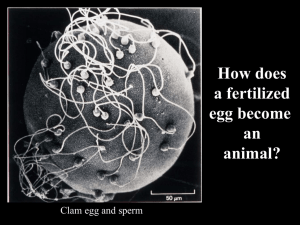paper
advertisement
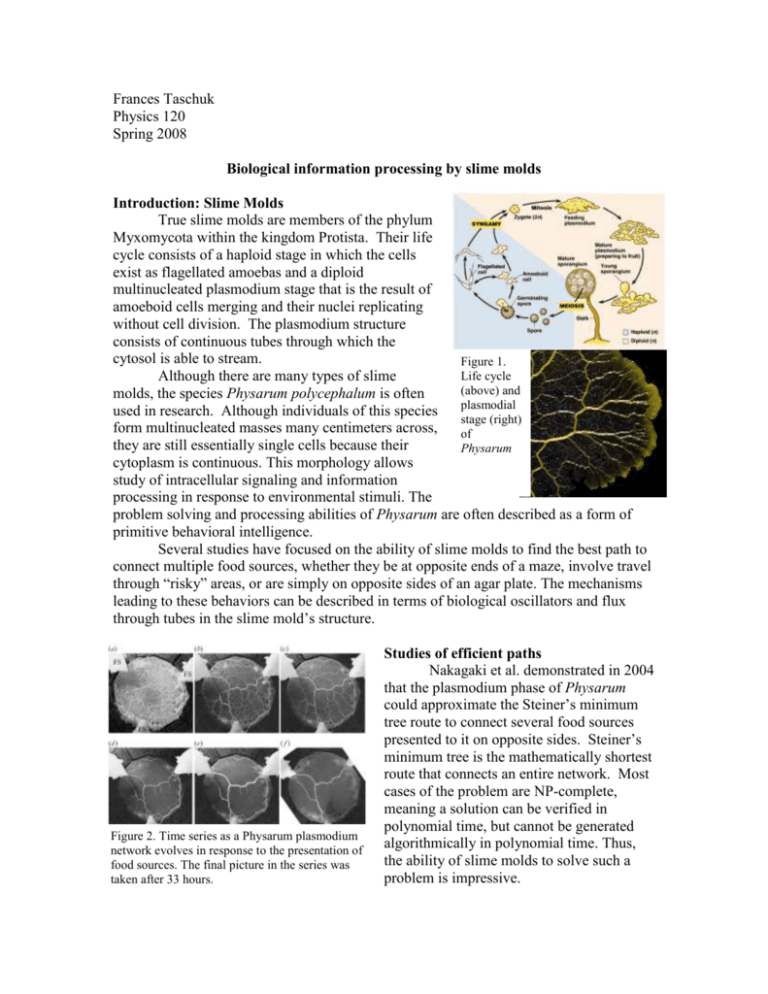
Frances Taschuk Physics 120 Spring 2008 Biological information processing by slime molds Introduction: Slime Molds True slime molds are members of the phylum Myxomycota within the kingdom Protista. Their life cycle consists of a haploid stage in which the cells exist as flagellated amoebas and a diploid multinucleated plasmodium stage that is the result of amoeboid cells merging and their nuclei replicating without cell division. The plasmodium structure consists of continuous tubes through which the cytosol is able to stream. Figure 1. Life cycle Although there are many types of slime (above) and molds, the species Physarum polycephalum is often plasmodial used in research. Although individuals of this species stage (right) form multinucleated masses many centimeters across, of they are still essentially single cells because their Physarum cytoplasm is continuous. This morphology allows study of intracellular signaling and information processing in response to environmental stimuli. The problem solving and processing abilities of Physarum are often described as a form of primitive behavioral intelligence. Several studies have focused on the ability of slime molds to find the best path to connect multiple food sources, whether they be at opposite ends of a maze, involve travel through “risky” areas, or are simply on opposite sides of an agar plate. The mechanisms leading to these behaviors can be described in terms of biological oscillators and flux through tubes in the slime mold’s structure. Figure 2. Time series as a Physarum plasmodium network evolves in response to the presentation of food sources. The final picture in the series was taken after 33 hours. Studies of efficient paths Nakagaki et al. demonstrated in 2004 that the plasmodium phase of Physarum could approximate the Steiner’s minimum tree route to connect several food sources presented to it on opposite sides. Steiner’s minimum tree is the mathematically shortest route that connects an entire network. Most cases of the problem are NP-complete, meaning a solution can be verified in polynomial time, but cannot be generated algorithmically in polynomial time. Thus, the ability of slime molds to solve such a problem is impressive. The experiment consisted of growing a solid layer of Physarum’s plasmodium stage on agar. Food blocks were then added at certain positions. After about 30 hours, the final shapes of the networks could be observed. Network shapes were typically analogous to the either the SMT solution, a slightly less efficient (although more robust to disruption of a tube) cyclical solution, or a Figure 3. SMT and cyclical network patterns. combination of the two (Figure 3). Although SMT-like patterns were observed 26% of the the slime mold kept the total length of tubes time, while cyclical solutions were observed short when connecting the various food 20% of the time. (i) Structure analogous to sources, it did not find the Steiner point SMT. (ii) Top half analogous to SMT; bottom nodes form a cycle. (iii) The ideal precisely. Most junctions of SMT-like SMT solution. solutions were less than 5% longer than the ideal solution, but the junctions were not evenly distributed around the Steiner point. The physical principles at work here can be described in terms of efficient transport within the cell. The selection of short, thick tubes for slime mold networks corresponds to the most efficient flux of cellular contents through the tubes. These tubes are self-organized from actin fibers, which become oriented in the same direction as the stretching force that results from cytoplasmic streaming in response to rhythmic contraction of the organism. While not fundamentally different from the efficient path finding described above, this ability of slime molds allows them to solve mazes. Maze-solving by slime molds provides a stunning illustration of the power of cellular information processing. Computer modeling of cytoplasmic flux in Physarum plasmodia in mazes can correspond well to their observed behavior (Tero, 2007). The challenges of slime mold plasmodia seeking Figure 4. Maze solution efficient paths can be further complicated by exposing them to found by Physarum light in one part of the path. Since the extension of plasmodia is slowed when the organism is exposed to light, the path of maximum efficiency is no longer a straight line between the two food sources. Nevertheless, slime molds can find this path in a way consistent with predictions of the path that would provide minimum risk to the slime mold, given knowledge about how Figure 5. Comparison of observed much growth is slowed under different light path (dots) with predicted path (dotted line). The part of the figure above the conditions (Nakagaki, 2007) Cellular “memory” Another set of experiments have demonstrated that Physarum plasmodia are able to horizontal line is the lighted area. Notice how much less of the path is exposed to light than would be for a direct diagonal path. (Nakagaki, 2007) anticipate periodic stimuli. The speed of linear growth of a plasmodium is decreased under cooler and drier conditions. Repeated stimulations of plasmodia with cool, dry air at consistent intervals of 60 minutes caused the organism to decrease its growth again after the next period, even without stimulation. This response dies out after a few more periods, but can be brought back by providing a single additional stimulation. The mechanism for such behavior is unknown, but it may be the result of natural biochemical oscillations within the organism that interact over a distance by diffusion with the result of synchronizing their phase (Tero, 2008). Conclusions The ability of cells to respond to the environments they encounter is the result of a complicated network of biochemical interactions and physical constraints. As we have seen many times this semester, sophisticated and interesting behaviors of biological systems can often be approached with models derived from underlying physical principles of the system. In the case of slime molds, the phenomenon of cytoplasmic streaming plays a key role not only in distribution of materials throughout the cell, but, by doing so in ways that maximize efficiency, in explaining the morphology of the entire plasmodium. The examples given above demonstrate that single cells have enough processing power to solve interesting problems as part of their natural response to their environment. Such observations lead to biologically-inspired applications. In some applications, cellular circuits may be preferable to programmed circuits because the plasticity of living organisms allows them to interact effectively with unknown environments. Systems using a slime mold to sense light and control the movement of a robot are one such example (see Tsuda, 2006). Conforming to physical principles, biological systems display a remarkable ability to adapt their behavior to survive successfully and efficiently. References: Nakagaki, T., Iima, M., Ueda, T., Nishiura, Y., Saigusa, T., Tero, A., Kobayashi, R., Showalter, K. 2007. Minimum-risk path finding by an adaptive amoebal network. Physical Review Letters 99. Nakagaki, T., Kobayashi, R., Nishiura, Y., Ueda, T. 2004. Obtaining multiple separate food sources: behavioural intelligence in the Physarum plasmodium. Proc. R. Soc. B. 271: 2305-2310. “Steiner Tree”. Retrieved May 16, 2008 from http://en.wikipedia.org/wiki/Steiner_tree. Tero, A., Kobayashi, R., Nakagaki, T. 2007. A mathematical model for adaptive transport network in path finding by true slime mold. Journal of Theoretical Biology 244: 553-564. Tero, A., Nakagaki, T. 2008. Amoebae anticipate periodic events. Physical Review Letters 100: 018101. Tsuda, S., Zauner, K-P., Gunji, Y-P. 2006. Robot control with biological cells. Biosystems 87: 215-223. Additional images from: http://kentsimmons.uwinnipeg.ca/16cm05/16labman05/lb2pg1_files/Physarum_polyceph alum.jpg http://io.uwinnipeg.ca/~simmons/16cm05/1116/28-29-PlasmSlimeMoldLife-L.gif


